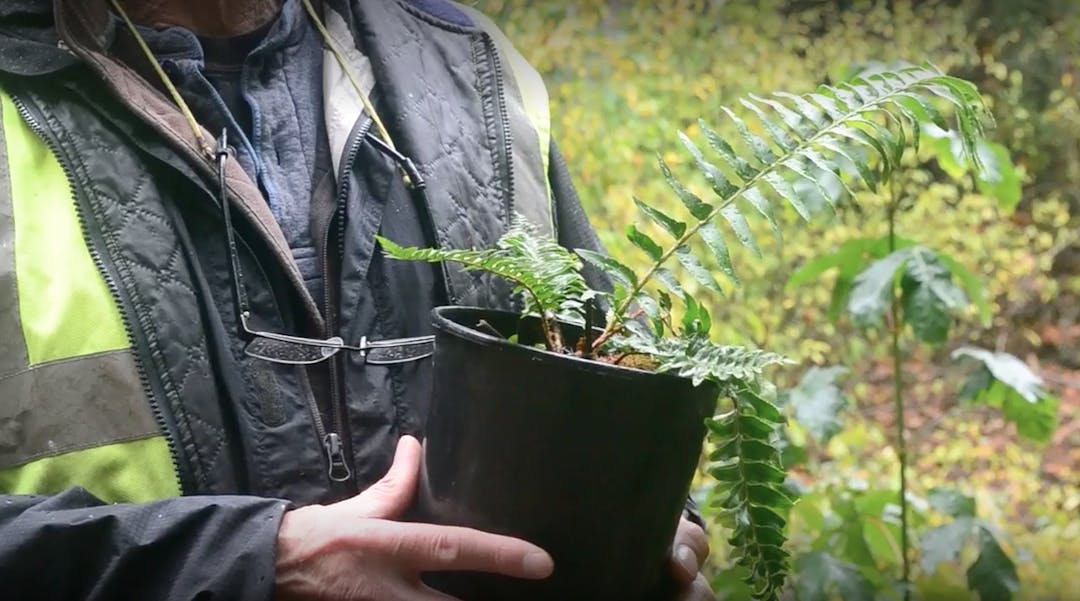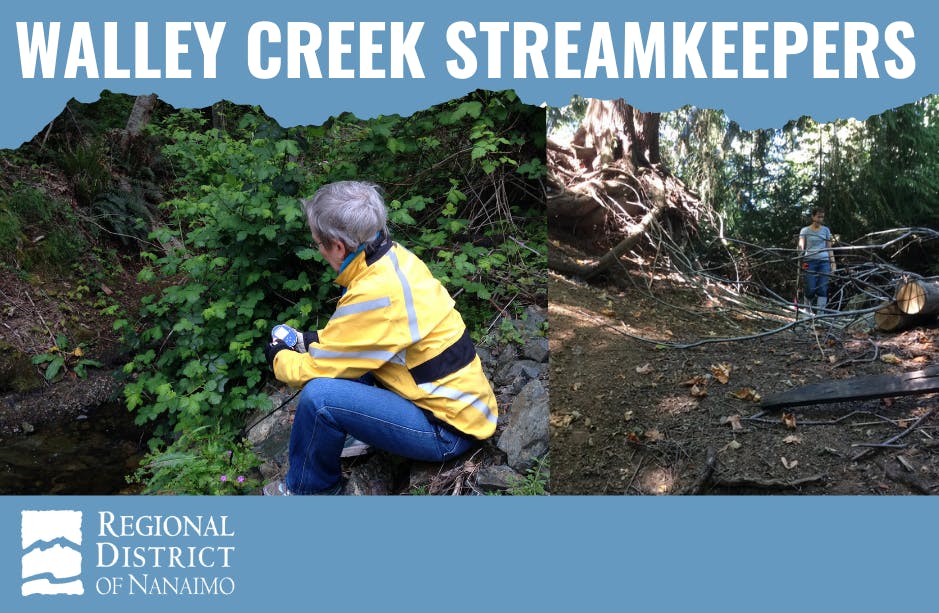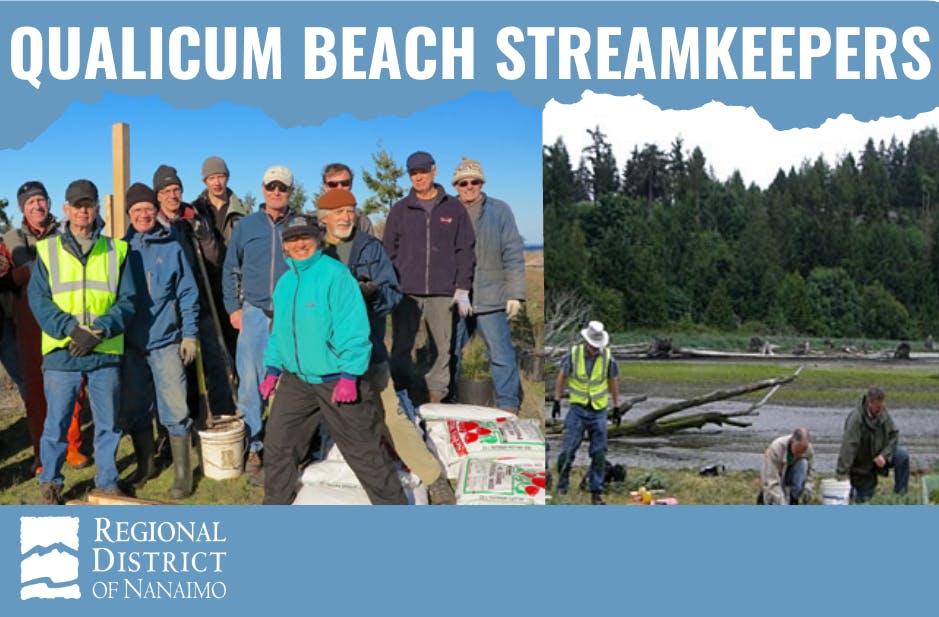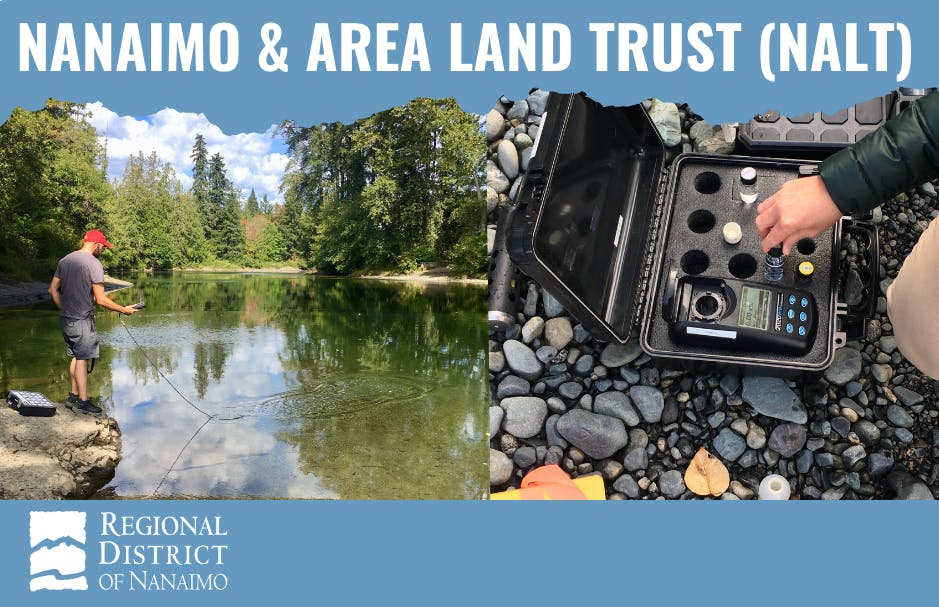Watershed Stewardship Network

Welcome to the Regional District of Nanaimo's Watershed Stewardship Network.
The RDN's Drinking Water & Watershed Protection(External link) (DWWP) program's vision is for healthy and resilient water resources and freshwater ecosystems - now and into the future.
This platform is an interactive space for members to share stories, post ideas, recruit volunteers, and showcase the valuable work that they do to monitor, restore, and steward freshwater habitat region wide.
Members of the Community Watershed Monitoring Network(External link) (CWMN) can find resources, guides, and training videos on this page. If you are a community member interested in getting involved with the monitoring program, contact waterstewardship@rdn.bc.ca(External link) to be connected with a stewardship group in your area.
Search and post volunteer opportunities in the Call out for Volunteers forum and check Key Dates for upcoming events, stewardship activities, and training opportunities.
Don't forget to Register to receive updates and stay involved!
Contact waterstewardship@rdn.bc.ca(External link) with any questions.
Welcome to the Regional District of Nanaimo's Watershed Stewardship Network.
The RDN's Drinking Water & Watershed Protection(External link) (DWWP) program's vision is for healthy and resilient water resources and freshwater ecosystems - now and into the future.
This platform is an interactive space for members to share stories, post ideas, recruit volunteers, and showcase the valuable work that they do to monitor, restore, and steward freshwater habitat region wide.
Members of the Community Watershed Monitoring Network(External link) (CWMN) can find resources, guides, and training videos on this page. If you are a community member interested in getting involved with the monitoring program, contact waterstewardship@rdn.bc.ca(External link) to be connected with a stewardship group in your area.
Search and post volunteer opportunities in the Call out for Volunteers forum and check Key Dates for upcoming events, stewardship activities, and training opportunities.
Don't forget to Register to receive updates and stay involved!
Contact waterstewardship@rdn.bc.ca(External link) with any questions.
-
New RDN funding program for Demonstration Sites and Interpretive Signs!
Share New RDN funding program for Demonstration Sites and Interpretive Signs! on Facebook Share New RDN funding program for Demonstration Sites and Interpretive Signs! on Twitter Share New RDN funding program for Demonstration Sites and Interpretive Signs! on Linkedin Email New RDN funding program for Demonstration Sites and Interpretive Signs! link01 Mar 2023
We are very excited to announce a new funding program - the Demonstration Sites & Interpretive Signage funding program!
The Regional District of Nanaimo’s Drinking Water & Watershed Protection (DWWP) Action Plan 2.0(External link) (Action 5.1.1) has identified the use of demonstration sites and interpretive signage as a meaningful to way to bring awareness to watershed features, watershed restoration and stewardship, and nature-based urban infrastructure that restore or protect watershed function.
Demonstration sites are real-world examples of features, practices, or infrastructure that inspire stewardship, action, or adoption of behaviours that are beneficial to communities and the environment. Examples of demonstration sites of green infrastructure (urban infrastructure that incorporates nature-based solutions that aim to retain or restore ecological function) include raingardens, bioswales, xeriscape gardens, rainwater harvesting practices, green rooftops, pervious surfaces, and more.
Interpretive signage is an effective and engaging way to bring public awareness to the function and importance of natural ecosystems and community efforts that aim to restore or protect those ecosystems. Together, demonstration sites and interpretive signs are a powerful tool to illustrate water sustainable practices, highlight the importance of healthy watersheds, and promote freshwater conservation.
The Demonstration Site & Interpretive Signage funding program supports the efforts of community organizations, stewardship groups, local government, and First Nations by offering to fund up to $5,000 for the installation or enhancement of demonstration sites and/or interpretive signage.
First Nations and municipal governments within the Regional District of Nanaimo, community organizations, non-profit environmental stewardship groups, as well as Regional District of Nanaimo (RDN) departments, may be eligible to apply for up to $5,000 (or greater based on project need and available funds) for demonstration site installation or enhancement and/or interpretive signage.
Other community groups or organizations may be considered eligible if the proposed project matches the merits of the program and aligns with DWWP initiatives.
Priority may be given to organizations that have partnered on other DWWP initiatives, such as those who have participated in the Community Watershed Monitoring Network(External link).
To submit a project proposal, complete the online application available on our webpage here(External link) or by emailing waterstewardship@rdn.bc.ca(External link).
Submissions must include:
- Contact name and organization,
- Brief description of the project, including:
- Project type (eg. rain garden and sign installation, green roof upgrade and sign installation, sign installation only at an existing site, etc.),
- Location of the project within the RDN,
- Project timeline (estimate of the project start and end dates),
- Project site description and visibility (i.e. the level of public accessibility to the site),
- The scale of installation (i.e. new demonstration site and sign installation, site improvement to an existing site with sign installation, or sign installation only)
- Estimate of project costs and list of any funding contributors or donators, including in-kind donations and support,
- The amount of Demonstration Site & Interpretive Signage program funds requested,
- List of project partners and description of the level of involvement or support from First Nations,
- Brief description of how and why the project site was chosen, as well as why the community would benefit from the education, awareness, and information provided by the site and/or sign.
- Description of a site maintenance plan.
Project submissions do not guarantee funding approval. Project proposals will be evaluated against a set of prioritization criteria and funding availability.
Contact waterstewardship@rdn.bc.ca(External link) with any questions or to discuss demonstration site and interpretive signage project ideas.
-
Stewardship Seed Funding - now open and accepting applications!
Share Stewardship Seed Funding - now open and accepting applications! on Facebook Share Stewardship Seed Funding - now open and accepting applications! on Twitter Share Stewardship Seed Funding - now open and accepting applications! on Linkedin Email Stewardship Seed Funding - now open and accepting applications! link26 Jun 2023CLOSED: This discussion has concluded.
The Drinking Water & Watershed Protection Stewardship Seed Funding(External link) (SSF) program is now open for applications for 2023 projects!
The RDN's Drinking Water & Watershed Protection(External link) (DWWP) program supports the efforts of local stewardship groups involved in community-level action to monitor, restore, or enhance regional watersheds by offering seed funding of $1000 to $5,000 per project. Multi-year projects can apply annually for up to three consecutive years.
To be eligible for Stewardship Seed Funding, projects must:
- be led by a non-profit organization and involve community volunteers,
- be jointly funded by other partners, donors, or with in-kind contributions,
- acquire all the necessary permissions and permits for work to be carried out,
- and they must actively enhance or monitor stream, river, lake, estuary, or wetland health, hydrology, or function.
Funding is available to all organizations and projects that match the above criteria and align with DWWP goals, though priority in the program is given to groups pursuing recommended actions generated from RDN supported stream assessments or water quality monitoring, such as the Community Watershed Monitoring Network(External link).
To apply, organizations must:
- Step 1: Submit a Pre-approval Application(External link) with estimated project costs, site overview, and any other requested information.
- Step 2: Once approved, complete the outlined project work within the same year as applying to the program.
- Step 3: Submit a Claim Application(External link) with an itemized breakdown of project costs, invoices/receipts for project materials and services, and any other requested information, such as project completion site photos and site maintenance plan.
There is no application deadline - allocations are 'first come, first served' based on project merit until years-end or until program funds are exhausted.
Complete program details and application forms are available online at https://www.rdn.bc.ca/stewardship-seed-funding(External link). Applications and any questions can be submitted to waterstewardship@rdn.bc.ca(External link).
-
Riparian Analysis Map
Share Riparian Analysis Map on Facebook Share Riparian Analysis Map on Twitter Share Riparian Analysis Map on Linkedin Email Riparian Analysis Map link01 Dec 2022
Our region is experiencing increased air and water temperatures, prolonged drought periods, and increased frequency of high intensity rainfall events as a result of climate change. To buffer these extremes, intact and functional riparian areas are essential for promoting cooler air and water temperatures in heatwaves, offering water filtration and flood protection during high rainfall events, and providing overall enhanced biodiversity, ecosystem services and climate resilience.
To understand the state of riparian cover across the region’s major watercourses and guide future restoration and enhancement efforts, the RDN’s Drinking Water & Watershed Protection (DWWP) engaged with McTavish Resource & Management Ltd to determine current functional riparian cover levels across the region’s watersheds, using aerial imagery, remote sensing data, and existing water quality data collected through the RDN’s Community Watershed Monitoring Network.(External link)
The Regional Riparian Spatial Analysis for Restoration Prioritization(External link) project assessed the riparian condition of 47 waterways across the RDN based on a prioritization scheme that considers eight parameters associated with riparian health, including:
- Disturbance,
- Zones of concern,
- Vegetation cover,
- Terrestrial habitat cover and continuity,
- Vegetation complexity and structural diversity,
- Soil parent material and texture,
- Water quality, and
- Climate
The goal of this assessment is to identify priority areas for restoration of riparian vegetative buffers and enhance climate resilience and water protection in the region.
An outcome of this project included the development of an interactive mapping tool that allows decision-makers, water stewards, and community members to interact with the results of the riparian spatial analysis and support the prioritization of restoration and enhancement efforts. Users of the Riparian Analysis Map Viewer can interact with a visual depiction of the results of the analysis, identify and prioritize areas for restorative efforts, as well as, build tailored maps with the use of a suite of informative layers, identifiers, and mark-ups to aid in the scoping and planning of restoration projects.
Visit the Riparian Analysis Map Viewer here: https://rdn.maps.arcgis.com/apps/webappviewer/index.html?id=86fedd424d9740f59445df46b3ae11dd(External link)
Your feedback is welcome! Don't hesitate to contact us with your comments, questions, or concerns by emailing waterstewardship@rdn.bc.ca(External link)
-
2022 CWMN Volunteer Appreciation Luncheon!
Share 2022 CWMN Volunteer Appreciation Luncheon! on Facebook Share 2022 CWMN Volunteer Appreciation Luncheon! on Twitter Share 2022 CWMN Volunteer Appreciation Luncheon! on Linkedin Email 2022 CWMN Volunteer Appreciation Luncheon! link29 Mar 2023CLOSED: This discussion has concluded.You are invited to attend a 2022 Community Watershed Monitoring Network Volunteer Appreciation Luncheon!
Join us on Saturday, November 19th, from 1:00 – 3:00pm at the McMillan Arts Centre in Parksville for a catered lunch, volunteer gear, door prizes, activities, and an opportunity to introduce your stewardship group to potential new volunteers.

The RDN’s Drinking Water & Watershed Protection team is so grateful to be partnered with 14 wonderful environmental stewardship groups, whose dedicated volunteer work make the Community Watershed Monitoring Network program a possibility.
After a couple years of postponement, we are delighted to host an in-person event to express our appreciation and gratitude for your participation.
This event will also be open to the public and those who may be interested in learning more about volunteering with a stewardship organization and participating in the Community Watershed Monitoring Network. There will be an opportunity to introduce your group to potential new volunteers from the public by having a display table or providing a short presentation.
Please register to attend by emailing waterstewardship@rdn.bc.ca(External link) and let me know:
- If your organization would like to have a display table at the event. We will provide tables for display materials and are happy to offer some assistance with developing and printing materials that highlight your group. The venue is booked for a couple of hours before and after the event, so there is plenty of time for setting-up and taking-down displays.
- If you would like to give a short 5-minute presentation about your group and the important work you do. There will be a projector, screen, and microphone available at the venue for presentations, if desired. If you are planning to present with PowerPoint slides, we will also have a computer available so you may bring your presentation on a USB or email your presentation to waterstewardship@rdn.bc.ca(External link) prior to the event.
- If you have photos that you’d like to share of watersheds and water stewards. We will be putting together a photo slideshow of local streams and the folks who work so hard to care for them. If you have any photos that you would like to share, please don’t hesitate to send them now and throughout the upcoming monitoring season to waterstewardship@rdn.bc.ca(External link).
We are very much looking forward to hosting you and hope to see you there!
How to use the features on this page:
Community Watershed Monitoring Stewardship Group Profiles
Community Watershed Monitoring Network Info & Equipment Guides
-
 CWMN Information
CWMN Information
-
 CWMN Monitoring Maps by Group
CWMN Monitoring Maps by Group
-
 Beaufort Watershed Stewards (3.54 MB) (pdf)
Beaufort Watershed Stewards (3.54 MB) (pdf)
-
 Cat Stream Stewards (2.14 MB) (pdf)
Cat Stream Stewards (2.14 MB) (pdf)
-
 Departure Creek Streamkeepers (1.99 MB) (pdf)
Departure Creek Streamkeepers (1.99 MB) (pdf)
-
 Fanny Bay Salmonid Enhancement Society (1.42 MB) (pdf)
Fanny Bay Salmonid Enhancement Society (1.42 MB) (pdf)
-
 Friends of French Creek (2.4 MB) (pdf)
Friends of French Creek (2.4 MB) (pdf)
-
 Gabriola Streamkeepers (1.85 MB) (pdf)
Gabriola Streamkeepers (1.85 MB) (pdf)
-
 Island Waters Fly Fishers Combined (3.26 MB) (pdf)
Island Waters Fly Fishers Combined (3.26 MB) (pdf)
-
 Island Waters Fly Fishers - Group A (2.57 MB) (pdf)
Island Waters Fly Fishers - Group A (2.57 MB) (pdf)
-
 Island Waters Fly Fishers - Group B (2.79 MB) (pdf)
Island Waters Fly Fishers - Group B (2.79 MB) (pdf)
-
 Mid Vancouver Island Habitat Enhancement Society (2.17 MB) (pdf)
Mid Vancouver Island Habitat Enhancement Society (2.17 MB) (pdf)
-
 MVIHES Nanoose Group (2.38 MB) (pdf)
MVIHES Nanoose Group (2.38 MB) (pdf)
-
 Nanaimo & Area Land Trust (2.39 MB) (pdf)
Nanaimo & Area Land Trust (2.39 MB) (pdf)
-
 Nile Creek Enhancement Society (1.41 MB) (pdf)
Nile Creek Enhancement Society (1.41 MB) (pdf)
-
 Qualicum Beach Streamkeepers (2.26 MB) (pdf)
Qualicum Beach Streamkeepers (2.26 MB) (pdf)
-
 Quennell Lake Watershed Stewardship Society (1.38 MB) (pdf)
Quennell Lake Watershed Stewardship Society (1.38 MB) (pdf)
-
 Vancouver Island University (1.9 MB) (pdf)
Vancouver Island University (1.9 MB) (pdf)
-
 Walley Creek Streamkeepers (1.57 MB) (pdf)
Walley Creek Streamkeepers (1.57 MB) (pdf)
-
 Wexford Creek Streamkeepers (1.77 MB) (pdf)
Wexford Creek Streamkeepers (1.77 MB) (pdf)
-
-
 CWMN Equipment Guides
CWMN Equipment Guides
-
 YSI Pro Plus Meter Calibration Cheat Sheet (790 KB) (pdf)
YSI Pro Plus Meter Calibration Cheat Sheet (790 KB) (pdf)
-
 YSI 2030 Meter Calibration Cheat Sheet (621 KB) (pdf)
YSI 2030 Meter Calibration Cheat Sheet (621 KB) (pdf)
-
 Hach Turbidity Meter Cheat Sheet (175 KB) (pdf)
Hach Turbidity Meter Cheat Sheet (175 KB) (pdf)
-
 Hanna pH Tester Calibration Cheat Sheet (559 KB) (pdf)
Hanna pH Tester Calibration Cheat Sheet (559 KB) (pdf)
-
 CWMN iPad Avenza Application Cheat Sheet (207 KB) (pdf)
CWMN iPad Avenza Application Cheat Sheet (207 KB) (pdf)
-
 QA/QC Lab Analysis Cheat Sheet (475 KB) (pdf)
QA/QC Lab Analysis Cheat Sheet (475 KB) (pdf)
-
Community Watershed Monitoring Network Reports & Presentations
-
 CWMN Reports
CWMN Reports
-
 Community Watershed Monitoring Data Analysis (2011-2020) (31.8 MB) (pdf)
Community Watershed Monitoring Data Analysis (2011-2020) (31.8 MB) (pdf)
-
 Surface Water Quality Trend Analysis for RDN Community Watershed Monitoring Data (2011-2017) (18.5 MB) (pdf)
Surface Water Quality Trend Analysis for RDN Community Watershed Monitoring Data (2011-2017) (18.5 MB) (pdf)
-
 2015 Lab Analysis Report - IWFF DCS VIU (1.82 MB) (pdf)
2015 Lab Analysis Report - IWFF DCS VIU (1.82 MB) (pdf)
-
 2012 -2015 Water Quality Trend Report - Nanoose Streamkeepers (1.01 MB) (pdf)
2012 -2015 Water Quality Trend Report - Nanoose Streamkeepers (1.01 MB) (pdf)
-
 2012-2014 Water Quality Trend Report (1.88 MB) (pdf)
2012-2014 Water Quality Trend Report (1.88 MB) (pdf)
-
 2014 Data Summary Report (2.64 MB) (pdf)
2014 Data Summary Report (2.64 MB) (pdf)
-
 2011-2013 Water Quality Trend Report (2.6 MB) (pdf)
2011-2013 Water Quality Trend Report (2.6 MB) (pdf)
-
 2013 Data Summary Report (1.24 MB) (pdf)
2013 Data Summary Report (1.24 MB) (pdf)
-
 2012 Data Summary Report (710 KB) (pdf)
2012 Data Summary Report (710 KB) (pdf)
-
 2011 Data Summary Report (666 KB) (pdf)
2011 Data Summary Report (666 KB) (pdf)
-
-
 2020 Water Region Summaries
2020 Water Region Summaries
-
 2021 Water Region Summaries
2021 Water Region Summaries
-
 2022 Water Region Summaries
2022 Water Region Summaries
-
 2023 Water Region Summaries
2023 Water Region Summaries
-
 CWMN Presentations
CWMN Presentations
-
 2024 Results Session - Data Summary and Guest Speaker Presentations (118 MB) (pdf)
2024 Results Session - Data Summary and Guest Speaker Presentations (118 MB) (pdf)
-
 2022 CWMN Results Session presenting 2021 Data (38.3 MB) (pdf)
2022 CWMN Results Session presenting 2021 Data (38.3 MB) (pdf)
-
 2021 CWMN Results Session presenting 2020 Data (14.9 MB) (pdf)
2021 CWMN Results Session presenting 2020 Data (14.9 MB) (pdf)
-
 2020 CWMN Results Session presenting 2019 Data (18.8 MB) (pdf)
2020 CWMN Results Session presenting 2019 Data (18.8 MB) (pdf)
-
 2019 CWMN Results Session presenting 2018 Data (13.8 MB) (pdf)
2019 CWMN Results Session presenting 2018 Data (13.8 MB) (pdf)
-
 2018 CWMN Results Session presenting 2017 Data (3.53 MB) (pdf)
2018 CWMN Results Session presenting 2017 Data (3.53 MB) (pdf)
-
 2017 CWMN Results Session presenting 2016 Data (4 MB) (pdf)
2017 CWMN Results Session presenting 2016 Data (4 MB) (pdf)
-
 2016 CWMN Results Session presenting 2015 Data (3.97 MB) (pdf)
2016 CWMN Results Session presenting 2015 Data (3.97 MB) (pdf)
-
Riparian Analysis Map
The Riparian Spatial Analysis for Restoration Prioritization(External link) investigates functional riparian cover across 47 waterways within the Regional District of Nanaimo. 
Users of the Riparian Analysis Map Viewer can interact with a visual depiction of the results of the analysis, identify and prioritize areas for restorative efforts, as well as, build tailored maps with the use of a suite of informative layers, identifiers, and mark-ups to aid in the scoping and planning of restoration projects.
Click here(External link) to open the Map Viewer or visit www.rdn.bc.ca/riparian-analysis-map(External link)
Grants & Funding Opportunities
Organizations Providing Funding for Habitat Restoration Projects
Outreach & Educational Materials
-
 Team WaterSmart Outdoor Brochures
Team WaterSmart Outdoor Brochures
-
 TWS Outdoor Brochure - Alternatives to Pesticides (3.29 MB) (pdf)
TWS Outdoor Brochure - Alternatives to Pesticides (3.29 MB) (pdf)
-
 TWS Outdoor Brochure - Healthy Lawn Care (3.29 MB) (pdf)
TWS Outdoor Brochure - Healthy Lawn Care (3.29 MB) (pdf)
-
 TWS Outdoor Brochure - Top 10 Irrigation Tips (2.33 MB) (pdf)
TWS Outdoor Brochure - Top 10 Irrigation Tips (2.33 MB) (pdf)
-
 TWS Outdoor Brochure - Utilizing Rain Barrels (2.59 MB) (pdf)
TWS Outdoor Brochure - Utilizing Rain Barrels (2.59 MB) (pdf)
-
 TWS Outdoor Brochure - Water Wise Gardening (1.24 MB) (pdf)
TWS Outdoor Brochure - Water Wise Gardening (1.24 MB) (pdf)
-
 Streamside Landowners Guide Brochure (18.6 MB) (pdf)
Streamside Landowners Guide Brochure (18.6 MB) (pdf)
-
-
 Team WaterSmart Indoor Brochures
Team WaterSmart Indoor Brochures
-
 Team WaterSmart Handouts
Team WaterSmart Handouts
-
 TWS FAQ Handout - May 2018 (1.06 MB) (pdf)
TWS FAQ Handout - May 2018 (1.06 MB) (pdf)
-
 Toilet Leaks - Identification and Repair Guide (840 KB) (pdf)
Toilet Leaks - Identification and Repair Guide (840 KB) (pdf)
-
 TWS How To Check For A Leak - May 2018 (136 KB) (pdf)
TWS How To Check For A Leak - May 2018 (136 KB) (pdf)
-
 TWS Irrigation Scheduling Guidelines - May 2018 (579 KB) (pdf)
TWS Irrigation Scheduling Guidelines - May 2018 (579 KB) (pdf)
-
 TWS Landscape Guide to Water Efficiency - May 2018 (5.4 MB) (pdf)
TWS Landscape Guide to Water Efficiency - May 2018 (5.4 MB) (pdf)
-
 TWS Pesticide Recipe Cards - Updated May 2018 (978 KB) (pdf)
TWS Pesticide Recipe Cards - Updated May 2018 (978 KB) (pdf)
-
 TWS Handout Native Plants - May 2018 (590 KB) (pdf)
TWS Handout Native Plants - May 2018 (590 KB) (pdf)
-
 TWS Handout Rain Gardens - May 2018 (777 KB) (pdf)
TWS Handout Rain Gardens - May 2018 (777 KB) (pdf)
-
 TWS Handout Xeriscaping - June 2019 (1.49 MB) (pdf)
TWS Handout Xeriscaping - June 2019 (1.49 MB) (pdf)
-
 Climate Change in our Region - Impacts and Response (317 KB) (pdf)
Climate Change in our Region - Impacts and Response (317 KB) (pdf)
-
-
 Information on Groundwater
Information on Groundwater
-
 Groundwater Factsheet - Know the Climate Reality.pdf (904 KB) (pdf)
Groundwater Factsheet - Know the Climate Reality.pdf (904 KB) (pdf)
-
 Groundwater Factsheet - Know your Well.pdf (624 KB) (pdf)
Groundwater Factsheet - Know your Well.pdf (624 KB) (pdf)
-
 TWS What Is Saltwater Intrusion - May 2018 (376 KB) (pdf)
TWS What Is Saltwater Intrusion - May 2018 (376 KB) (pdf)
-
 Best Practices for Dug Wells (1.24 MB) (pdf)
Best Practices for Dug Wells (1.24 MB) (pdf)
-
 Guide to Conducting Pumping Tests (1.13 MB) (pdf)
Guide to Conducting Pumping Tests (1.13 MB) (pdf)
-
 Licensing Groundwater (136 KB) (pdf)
Licensing Groundwater (136 KB) (pdf)
-
 Upgrading Wells in Pits (1.03 MB) (pdf)
Upgrading Wells in Pits (1.03 MB) (pdf)
-
 Water Sustainability Act (104 KB) (pdf)
Water Sustainability Act (104 KB) (pdf)
-
 Well Disinfection (3.42 MB) (pdf)
Well Disinfection (3.42 MB) (pdf)
-
 Arsenic in Groundwater (1000 KB) (pdf)
Arsenic in Groundwater (1000 KB) (pdf)
-
 Bacteria in Groundwater (179 KB) (pdf)
Bacteria in Groundwater (179 KB) (pdf)
-
 Flowing Artesian Wells (2.04 MB) (pdf)
Flowing Artesian Wells (2.04 MB) (pdf)
-
 Fluoride in Groundwater (959 KB) (pdf)
Fluoride in Groundwater (959 KB) (pdf)
-
 Hardness in Groundwater (170 KB) (pdf)
Hardness in Groundwater (170 KB) (pdf)
-
 Iron and Manganese in Groundwater (167 KB) (pdf)
Iron and Manganese in Groundwater (167 KB) (pdf)
-
 Nitrate in Groundwater (967 KB) (pdf)
Nitrate in Groundwater (967 KB) (pdf)
-
 Sodium in Groundwater (940 KB) (pdf)
Sodium in Groundwater (940 KB) (pdf)
-
Drinking Water & Watershed Protection Educational Video Series
-
 Click here to play video
Video 1 - Watershed Wonders
Click here to play video
Video 1 - Watershed Wonders
-
 Click here to play video
Video 2 - The Incredible Journey
Click here to play video
Video 2 - The Incredible Journey
-
 Click here to play video
Video 3 - Water Connections
Click here to play video
Video 3 - Water Connections
-
 Click here to play video
Video 4 - Water Challenges
Click here to play video
Video 4 - Water Challenges
-
 Click here to play video
Video 5 - Water Science and Stewardship
Click here to play video
Video 5 - Water Science and Stewardship
-
 Click here to play video
Video 6 - The Water Sustainable Future
Click here to play video
Video 6 - The Water Sustainable Future
Related projects
Follow Project
Who's listening
-
Stewardship Coordinator - Drinking Water & Watershed Protection Program
Regional District of Nanaimo

-
Monitoring Network Coordinator - Drinking Water & Watershed Protection Program
Regional District of Nanaimo














